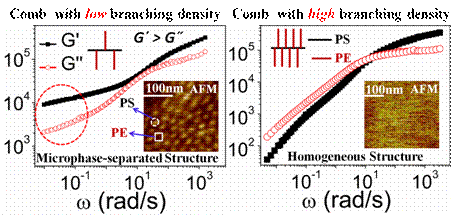| Nanostructure and Linear Rheological Response of Comb-like Copolymer PSVS-g-PE Melts: The Influences of Branching Densities and Branching Chain Length |
| From: PublishDate:2016-06-03 Hits: |
It is a hot topic how polymer architecture affect the microstructures and properties of polymer materials. For the comb-like copolymers, both the lengths and densities of branches could influence melt property. Currently, long-chain branched polymers with low graft density (below 100 branches per 10000 backbone carbon atom) and bottlebrush polymers (poly(macromonomer)s) with very high graft density (above 2000 branches per 10000 backbone carbon atom) have been studied in detail. However, what will happen for the comb-like copolymers with branching degree in the range of more than 100 branches per 10000 backbone carbon atom but lower than that of poly(macromonomer)s? What will happen when the backbone and side chain are incompatibility? A team from The State Key Laboratory of Polymer Physics and Chemistry of Changchun Institute of Applied Chemistry, Chinese Academy of Sciences, has studied this problem in detail. Their research has been published on October 8th, 2015 in Macromolecules. The team found that PSVS-g-PE copolymers with low branching density (115-125 branch chains per 10000 backbone carbon atom) showed a microphase-separated structure at the melt state, and a typical rheological characteristic for network-like structure was observed; PSVS-g-PE sample with high branching density (880-1225 branch chains per 10000 backbone carbon atom) showed homogeneous phase structure and normal rheological behavior. At the same time, the type of microphase-separated structure at the melt state strongly influences the applicability of the time-temperature superposition (TTS) principle.
The morphology of graft copolymers was characterized by SAXS performed at beamline 1W2A, BSRF, Beijing, China. There were not obvious peaks in the SAXS profile of scattering intensity for all the comb-like copolymers with high branching density, implying that there was no the formation of microphase separated structures in these melts. In contrary, there was a broad primary peak in the SAXS profiles, indicating the presence of microphase separation structure in these melts. The microphase separated structures change from lamellar-like structure to disorganized sphere-like structure with the lengths of branches increasing based on the spacing and intensity ratios, which have been confirmed by high temperature AFM observation. In all, the lengths and densities of branches in comb-like copolymers could influence melt morphology. This work provides a scientific clue for farther understanding the relationship between nonlinear topological structure and microscopic morphology. In this work, the synchrotron sources have helped the team to analysize specific microphase separated structure of comb-like copolymers PSVS-g-PE in detail, providing strong evidence for studying the relationship among branch structure, morphology, and melt rheological property. This work was cited by the famous polymer physicist, Frank S. Bates, at ACS Macro Lett.(2016,5,407): “Varying the backbone length and the size, composition, and density of the grafted chains will influence the rheological and mechanical properties”. http://pubs.acs.org/doi/abs/10.1021/acsmacrolett.6b00091 Article: Yichao Lin, Yanhui Wang, Jun Zheng, Kun Yao, Haiying Tan, Yaotao Wang, Tao Tang,* Donghua Xu* Nanostructure and Linear Rheological Response of Comb-like Copolymer PSVS-g-PE Melts: The Influences of Branching Densities and Branching Chain Length. Macromolecules 48(2015), 7640-7648. |
|
|
| Chinese
- Metal-free efficient photocatalyst for stable visible water splitting——Top ten major scientific progresses in China in 2015
- The nano-resolution imaging platform was awarded the first rate prize of Beijing Science and Technology in 2014
- Beamline 1W1 of BSRF started to runoperate in the couplingparasitic mode of BEPCII
- Synthesis of High Performance Polymer Materials for Field Effect-Transistors
- Surfactant molecular aggregates in green solvents
- GIXRD has played an important role in the characterization of organic thin-film transistors
Copyright © 2011 - 2012 Beijing Synchrotron Radiation Facility


